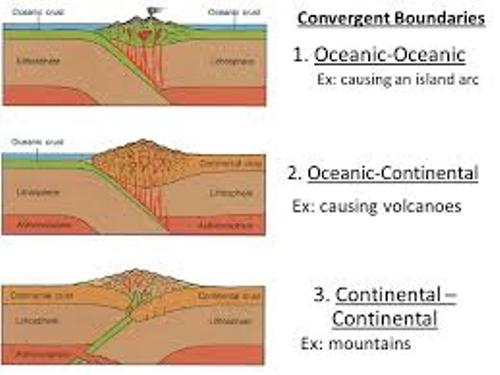10 Facts about Convergent Boundaries
The collision of two crustal plates is explained on Facts about Convergent Boundaries. This event leads into the formation of a subduction zone. One plate is located below the other plate. The subduction zone can only be formed if one of the plates is an oceanic plate. The Himalayas were formed when the two continent plates were collided the mountain ranges. Here are some interesting facts about convergent boundaries below:
Facts about Convergent Boundaries 1: the melting
The plate begins to melt at around 100 km when it is recycled. The molten rock is formed when the oceanic plate is soaked by the water.
Facts about Convergent Boundaries 2: the characteristics of the molten rock
Can you mention some characteristics of molten rock? If you compare it with the surrounding rocks, the molten rock is less dense and hotter. Moreover, it is buoyant.

Convergent Boundaries Image
Facts about Convergent Boundaries 3: a megathrust earthquake
When the subduction zone in the converging plates is locked, it leads into fracture. The flat line of the break which spans hundreds of kilometers can cause a megathrust earthquake.
Facts about Convergent Boundaries 4: Tsunami waves
The tsunami waves are caused by the movement of the plant. A megathrust earthquake which occurred a convergent boundary triggered the Indian Ocean Tsunami in 2004. Get facts about Asian Tsunami here.

Facts about Convergent Boundaries
Facts about Convergent Boundaries 5: the characteristics of convergent boundaries
Let’s find out the characteristics of convergent boundaries? The extensive earthquake activity is considered as the main characteristic. Find facts about Chile Earthquake here.
Facts about Convergent Boundaries 6: the example of the convergent plate boundaries
One of the examples of the presence of the convergent plate boundary is located in Nazca Pacific convergent boundary in Peru and Chile.

Convergent Boundaries
Facts about Convergent Boundaries 7: the types of convergent boundaries
There are three primary types of convergent boundaries. Those include continental-continental convergence, oceanic-oceanic convergence and oceanic-continental convergence.
Facts about Convergent Boundaries 8: An oceanic-oceanic convergent plate boundary
The occurrence of an oceanic-oceanic convergent plate boundary is seen when an oceanic plate sub-ducts each other.

Convergent Boundaries Pic
Facts about Convergent Boundaries 9: Marianas Trench
Marianas Trench is the example of the oceanic-oceanic convergent plate boundary. It was formed subduction because of the Philippine Plate over the Pacific plate.
Facts about Convergent Boundaries 10: a continental-continental plate boundary
The formation of the Himalayan and Tibetan Plateau is a result of a continental-continental plate boundary. It occurs when the Indian plate was collided with the Eurasian plate.

Ocean Convergent Boundaries
Do you have any comment on facts about convergent boundaries?


